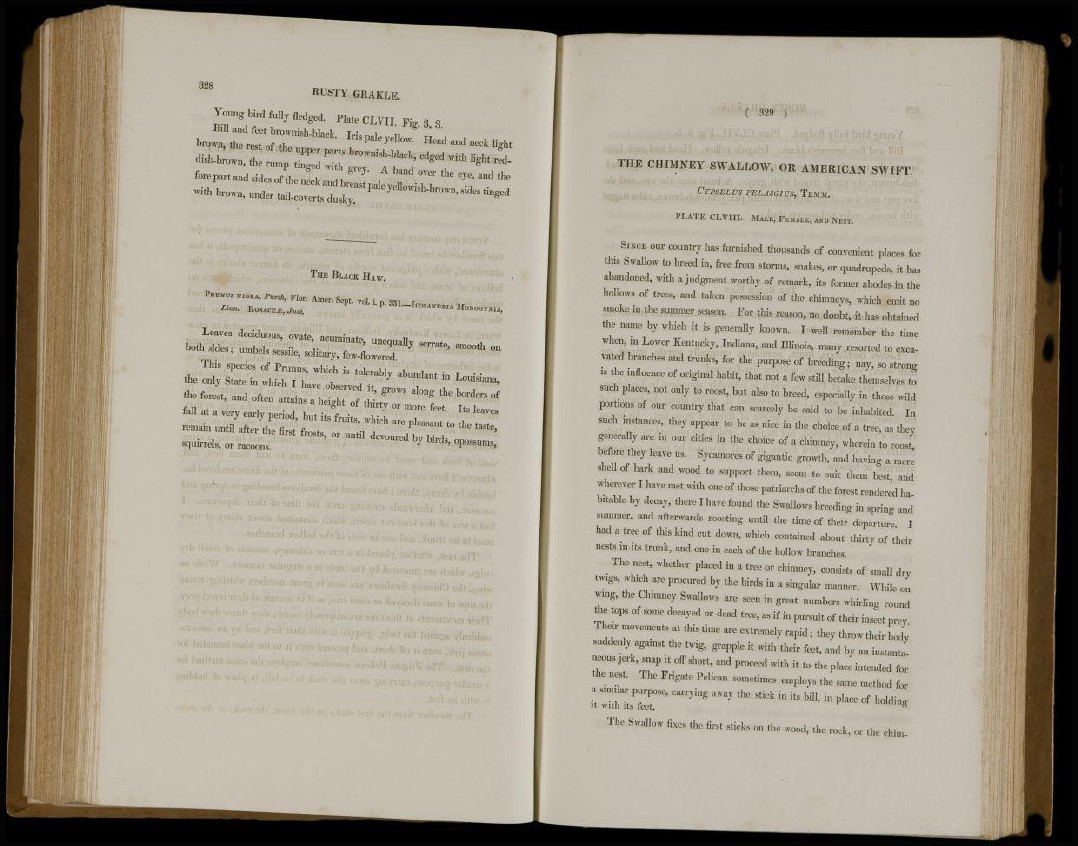
R U S T Y GRAKLE.
Young bird fully fledged. Plate CLVII. Fig. 3, 3.
Bill and feet brownish-black. Iris pale yellow. Head and neck light
brown, the rest of the upper parts brownish-black, edged with light reddish
brown, the rump tinged with grey. A band over the eye, and the
fore part and sides of the neck and breast pale yellowish-brown, sides tinged
with brown, under tail-coverts dusky.
THE BLACK HAW.
PRTJNUS NIGRA, Pursh, Flor. Amer. Sept. vol. i. p. 331.—ICOSANDRIA MONOGYNIA,
Linn. ItosACEiE, Juss.
Leaves deciduous, ovate, acuminate, unequally serrate, smooth on
both sides; umbels sessile, solitary, few-flowered.
This species of Prunus, which is tolerably abundant in Louisiana,
the only State in which I have observed it, grows along the borders of
the forest, and often attains a height of thirty or more feet. Its leaves
fall at a very early period, but its fruits, which are pleasant to the taste,
remain until after the first frosts, or until devoured by birds, opossums,
squirrels, or racoons.
( 329 )
THE CHIMNEY SWALLOW, OR AMERICAN SWIFT.
CYPSELUS PELASG1US, T E M M .
P L A T E C L V I I I . MALE, FEMALE, AND NEST.
SINCE our country has furnished thousands of convenient places for
this Swallow to breed in, free from storms, snakes, or quadrupeds, it has
abandoned, with a judgment worthy of remark, its former abodes in the
hollows of trees, and taken possession of the chimneys, which emit no
smoke in the summer season. For this reason, no doubt, it has obtained
the name by which it is generally known. I well remember the time
when, in Lower Kentucky, Indiana, and Illinois, many resorted to excavated
branches and trunks, for the purpose of breeding; nay, so strong
is the influence of original habit, that not a few still betake themselves to
such places, not only to roost, but also to breed, especially in those wild
portions of our country that can scarcely be said to be inhabited. In
such instances, they appear to be as nice in the choice of a tree, as they
generally are in our cities in the choice of a chimney, wherein to roost,
before they leave us. Sycamores of gigantic growth, and having a mere
shell of bark and wood to support them, seem to suit them best, and
wherever I have met with one of those patriarchs of the forest rendered habitable
by decay, there I have found the Swallows breeding in spring and
summer, and afterwards roosting until the time of their departure. I
had a tree of this kind cut down, which contained about thirty of their
nests in its trunk, and one in each of the hollow branches.
The nest, whether placed in a tree or chimney, consists of small dry
twigs, which are procured by the birds in a singular manner. While on
wing, the Chimney Swallows are seen in great numbers whirling round
the tops of some decayed or dead tree, as if in pursuit of their insect prey.
Their movements at this time are extremely rapid; they throw their body
suddenly against the twig, grapple it with their feet, and by an instantaneous
jerk, snap it off short, and proceed with it to the place intended for
the nest. The Frigate Pelican sometimes employs the same method for
a similar purpose, carrying away the stick in its bill, in place of holding
it with its feet.
The Swallow fixes the first sticks on the wood, the rock, or the chim